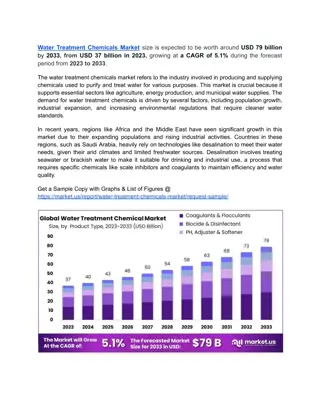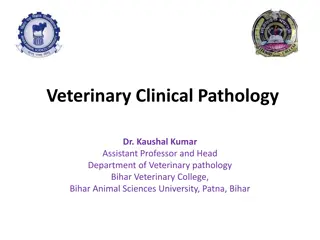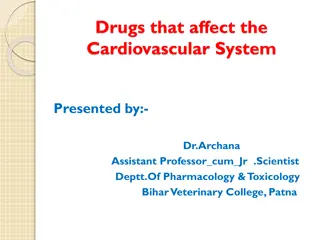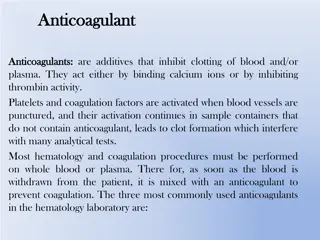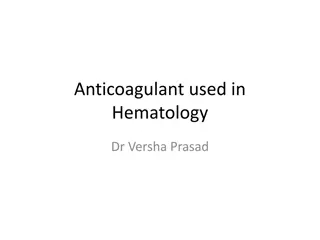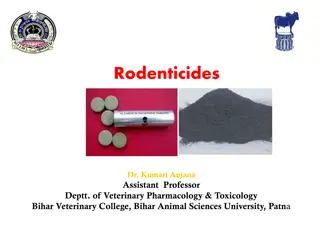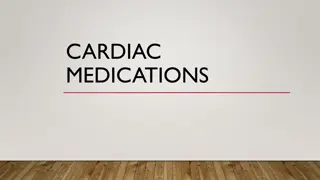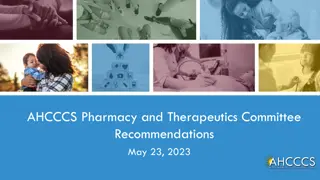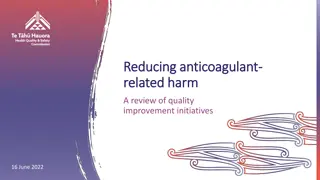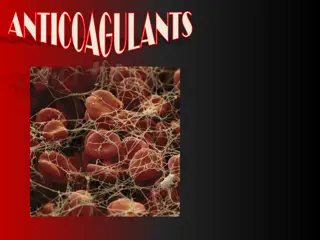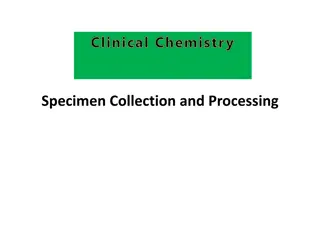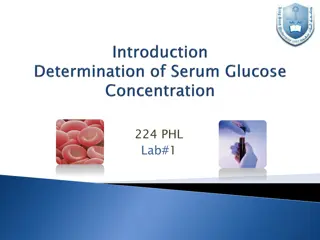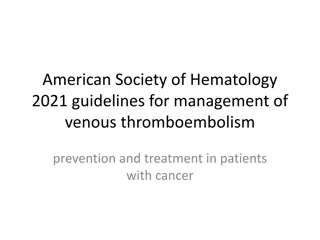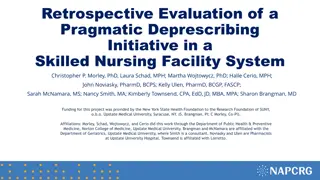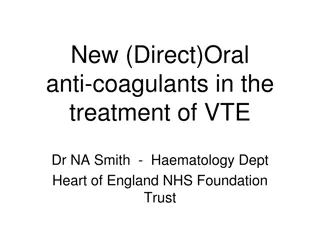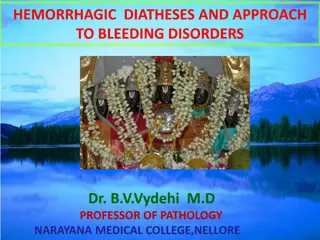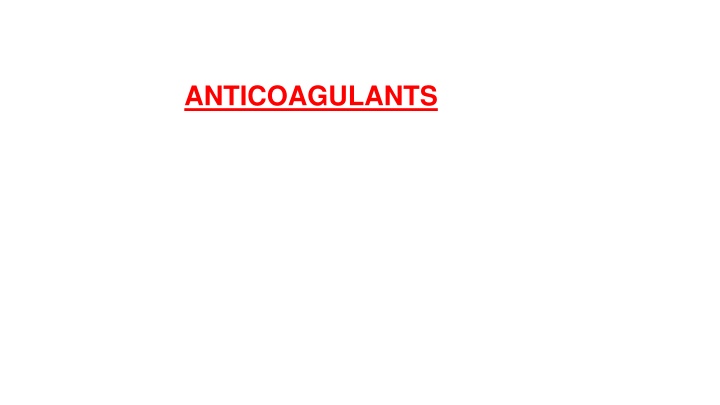
Anticoagulants and Their Classification
Explore the world of anticoagulants, essential drugs used to prevent blood clotting in various medical conditions. Learn about the classification of anticoagulants, including in-vivo and in-vitro types, and their different categories such as parenteral, oral, and complexing agents. Discover the key anticoagulant medications and their functions in clinical management and diagnostics.
Uploaded on | 1 Views
Download Presentation

Please find below an Image/Link to download the presentation.
The content on the website is provided AS IS for your information and personal use only. It may not be sold, licensed, or shared on other websites without obtaining consent from the author. If you encounter any issues during the download, it is possible that the publisher has removed the file from their server.
You are allowed to download the files provided on this website for personal or commercial use, subject to the condition that they are used lawfully. All files are the property of their respective owners.
The content on the website is provided AS IS for your information and personal use only. It may not be sold, licensed, or shared on other websites without obtaining consent from the author.
E N D
Presentation Transcript
T hese are drugs which are used to prevent the clotting of blood in prophylaxis and treatment of bleeding diathesis. Blood coagulation occurs instantaneously once a blood vessel has been injured.
In-vivo anticoagulants are used in clinical management and in- vitro anticoagulants are used in diagnostics. Heparin is included in both in-vitro and in-vivo antioagulants.
CLASSIFICATION ANTICOAGULANTS USED IN VITRO USED IN VIVO PARENTERAL CALCIUM COMPLEXING AGENTS ORAL HEPARIN
1) USED IN VIVO: A) PARENTERALANTICOAGULANTS: - INDIRECT THROMBIN INHIBITORS: INHIBITORS: Heparin Low molecular weight heparins Fondaparinux - DIRECT THROMBIN Lepirudin Bivalirudin Argatroban Danaparoid
B) ORALANTICOAGULANTS: - COUMARIN DERIVATIVES: Bishydroxcoumarin (dicumarol) Warfarin sodium Acenocoumarol Ethylbiscoumacetate -INDANDIONE DERIVATIVE: Phenindione -DIRECT FACTOR Xa INHIBITORS: Rivaroxaban -ORAL DIRECT THROMBIN INHIBITOR: Dabigatran etexilate
2) USED IN VITRO: A) HEPARIN: B) CALCIUM COMPLEXINGAGENTS: Sodium citrate Sodium oxalate Sodium edetate
HEPARIN Heparin is a non-uniform mixture of straight chain mucopolysaccharides with MW 10,000 to 20,000. It contains polymers of two sulfated disaccharide units: D-glucosamine-L-iduronic acid D-glucosamine-D-glucuronic acid It is present in all tissues containing mast cells; richest sources are lung, liver and intestinal mucosa.
ANTICOAGULANT ACTIONOF HEPARIN HEPARIN Activates plasma ATIII Heparin-AT III complex Binds to clotting factors of intrinsic and common pathways (Xa, IIa, IXa, XIa, XIIa and XIIIa) and inactivates them
OTHER ACTIONS OFHEPARIN Heparin in higher doses inhibits platelet aggregation and prolongs bleeding time.Heparin in lower doses helps in lipaemia clearing.
PHARMACOKINETICS It is not givenorally as it is not absorbed.If Injected i.v. - acts instantaneously.After s.c. injection anticoagulant effect develops after ~60 min.Bioavailability of s.c. heparin is inconsistent.Heparin does not cross blood-brain barrier or placenta (it is the anticoagulant of choice during pregnancy).It is metabolized in liver by heparinase.Fragments are excreted in urine.
Heparin should not be mixed with penicillin, tetracyclines, hydrocortisone or NA in the same syringe or infusion bottle. Heparinized blood is not suitable for blood counts (alters the shape of RBCs and WBCs), fragility testing and complement fixation tests.
ADVERSE EFFECTS Bleeding due to overdose - most serious complication.Thrombocytopenia - mild and transient.Transient and reversible alopecia is infrequent. Serum transaminase levels may rise Osteoporosis - long-term use of relatively high dose. Hypersensitivity reactions rare.
CONTRAINDICATIONS Bleeding disorders, history of heparin induced thrombocytopenia. Severe hypertension, threatened abortion, piles, g.i. ulcers. Subacute bacterial endocarditis, large malignancies, tuberculosis. Ocular and neurosurgery, lumbar puncture. Chronic alcoholics, cirrhosis, renal failure.
Low molecular weight (LMW) heparins Heparin has been fractionated into LMW forms (MW 3000 7000) by different techniques. LMWHs are defined as heparin salts having an average molecular weight of less than 8000 Da. These are obtained by various methods of fractionation or depolymerisation of polymeric heparin.
MECHANISM OFACTION Selectively inhibit factor Xa with little effect on IIa. Act only by inducing conformational change in ATIII Hence LMW heparins have smaller effect on aPTT and whole blood clotting time than unfractionated heparin (UFH) Also, they have lesser antiplatelet action less interference with haemostasis. Lower incidence of haemorrhagic complications compared to UFH Elimination - primarily by renal excretion.
ADVANTAGES OF LMW HEPARIN Better subcutaneous bioavailability (70 90%) compared to UFH (20 30%) Longer and more consistent monoexponential t (4 6 hours) Since aPTT/clotting times are not prolonged, laboratory monitoring is not needed. Risk of osteoporosis after long term use is much less.
INDICATIONS Prophylaxis of deep vein thrombosis and pulmonary embolism in high-risk patients undergoing surgery. Treatment of established deep vein thrombosis. Unstable angina and MI: they have largely replaced continuous infusion of UFH. To maintain patency of cannulae and shunts in dialysis patients.
A number of LMW heparins have been marketed- Enoxaparin Reviparin Nadroparin Dalteparin Parnaparin Ardeparin
DIRECT THROMBIN INHIBITORS Unlike heparin, these recently developed anticoagulants bind directly to thrombin and inactivate it without the need to combine with and activate ATIII. Lepirudin Bivalirudin Argatroban
ORALANTICOAGULANTS Act indirectly by interfering with the synthesis of vit K dependent clotting factors in liver. Apparently behave as competitive antagonists of vit K and lower the plasma levels of functional clotting factors in a dose-dependent manner. they inhibit the enzyme vit K epoxide reductase (VKOR) and interfere with regeneration of the active hydroquinone form of vit K which acts as a cofactor for the enzyme -glutamyl carboxylase.
USES OFANTICOAGULANTS Deep vein thrombosis (DVT) and pulmonary embolism (PE) Myocardial infarction (MI) Unstable angina Rheumatic heart disease; Atrial fibrillation(AF) Cerebrovascular disease Vascular surgery, prosthetic heart valves, retinal vessel thrombosis, extracorporeal circulation, haemodialysis Defibrination syndrome or disseminated intravascular coagulation

